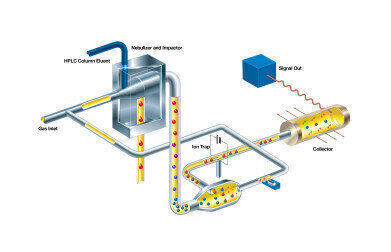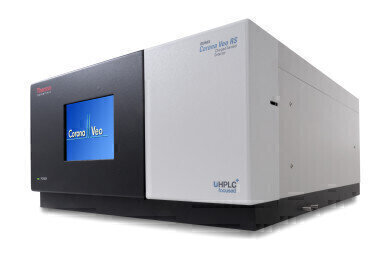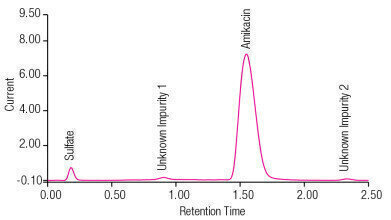-
 Figure 1. The internal schematic of a charged aerosol detector.
Figure 1. The internal schematic of a charged aerosol detector. -
 Figure 2. The Corona Veo charged aerosol detector.
Figure 2. The Corona Veo charged aerosol detector. -
 Figure 3. The UHPLC analysis of amikacin impurities using micro LC flow rate of 50 µL/min.
Figure 3. The UHPLC analysis of amikacin impurities using micro LC flow rate of 50 µL/min.
HPLC, UHPLC
Next-Generation Charged Aerosol Detector for LC
Jun 27 2013
The charged aerosol detector is now widely accepted as the universal detector of choice in liquid chromatography for quantitative analyses by food, pharma, biopharma and industrial companies. Expanding on its capabilities, the next-generation charged aerosol detector delivers improved precision, increased sensitivity and an enhanced linear dynamic range. An all new aerosol flow path widens the application scope and extends the flow-rate range for use with capillary, micro- and normal-bore columns.
Its popularity among analytical scientists is due to a combination of performance (sensitivity, reproducibility, and dynamic range) and robustness. With its novel technology for the detection of any non-volatile and many semi-volatile analytes, charged aerosol detection offers the distinct advantage of consistent response independent of chemical structure. This mass sensitive technology as shown in Figure 1 measures a signal that is in direct proportion to the amount of analyte present in a sample. These signals are derived from the measurement of an electrical charge originating from ionized nitrogen that is diffusionally transferred to the surface of the analyte particle. The signal obtained depends primarily upon particle size across a wide range and does not depend significantly upon individual analyte properties[1].
Figure 1. The internal schematic of a charged aerosol detector. This video provides a quick overview on how it works.
Charged aerosol detection delivers predictable results without the need for complex detector optimization. It is an ideal mass balance detector for the determination of relative analyte concentrations, even when reference standards are not available. With the flexibility and performance for analytical R&D, and the simplicity and reproducibility needed for manufacturing QC/QA, charged aerosol detection can be used for the analysis of pharmaceuticals (large and small molecule), biomolecules, foods and beverages, specialty chemicals, and polymers.
The Thermo Scientific™ Dionex™ Corona™ Veo™ charged aerosol detector (Figure 2) widens the envelope of LC conditions for mobile phase composition and offers an enhanced linear dynamic range for quantitative results from undetected peaks in a chromatographic analysis.
• Simple, intuitive operation
• Integration with any LC system
• Enhanced linear dynamic range
• Sub-nanogram sensitivity
• Expanded pH compatibility
Figure 2. The Corona Veo charged aerosol detector
The Corona Veo detector features a new FocusJet™ concentric nebulization system facilitating consistent droplet-to-particle generation to enhance performance, especially for the detection of semi-volatile compounds. It features an expanded flow rate range optimized from 0.01 to 2.0 mL/min for compatibility with micro LC applications using micro-bore columns as shown in Figure 3.
Figure 3. The UHPLC analysis of amikacin impurities using micro LC flow rate of
50 µL/min.
The Corona Veo detector can be used with any HPLC or UHPLC system and is an ideal complementary detector for use with UV or mass spectrometry (MS). This powerful combination of conventional detection, structure identification and unbiased universal detection is a perfect approach to maximize the amount of compound data obtained from a single analytical run.
The Corona Veo charged aerosol detector opens new opportunities for discovery and routine analysis – the ideal detector for every laboratory.
References
[1] Flagan R.C. : Aerosol Sci. & Technol. 28(4),301-380 (1998)
Digital Edition
Chromatography Today - Buyers' Guide 2022
October 2023
In This Edition Modern & Practical Applications - Accelerating ADC Development with Mass Spectrometry - Implementing High-Resolution Ion Mobility into Peptide Mapping Workflows Chromatogr...
View all digital editions
Events
May 05 2024 Seville, Spain
May 15 2024 Birmingham, UK
May 19 2024 Brno, Czech Republic
May 21 2024 Lagos, Nigeria
May 23 2024 Beijing, China













